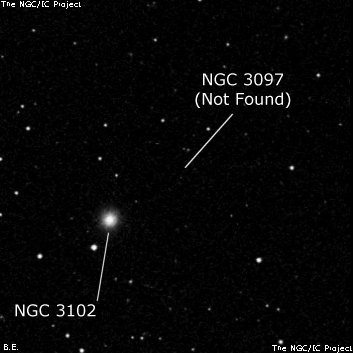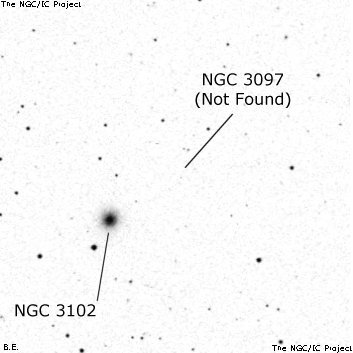NGC/IC Project Restoration Effort
(This is a very very beta version)
NGC3097


Basic Information
Location and Magnitude
Right Ascension: 10:3:58.4
Declination: +60:4:59
Constellation: UMA
Visual Magnitude: 14.1
Historic Information
Discoverer: Austin
Year of discovery: 1870
Discovery aperture: 15.0
Observational
Summary description: Neb *? 2' np h 662
Sub-type: *
Corwin's Notes
=====
NGC 3097. I cannot find this one. Here are the original observations from
the Harvard Annals, Vol. 8, Part 1, page 62, 1882:
"Date GC RA (1860.0) Dec Remarks
1870 Mar.24 -- 09 54 19.6 +60 47 58.2 G.C. 1998 s f neb; p 45 deg
s 2'. [Place only approximate.]
1870 Mar.24 1998 09 54 36.7 +60 46 33.3 G.C. 1998: F; S; R; mbMN."
There are three things to note about these observations:
1) The position of the second (GC 1998 = NGC 3102) is from the GC.
2) The "p 45 deg s 2' " means that the first (N3097) is 2' away
from GC1998 at a position angle of 45 degrees. This is
inconsistent with the position which implies the object to
be northwest, not northeast, of N3102.
3) Both observations are credited to E. P. Austin, and there is
a note for N3097:
"Perhaps a nebulous star. It is half-way between G.C. 1998
and a star 11 magn."
The positions don't tell us anything we don't already know since they are
correctly transfered into NGC from GC and the Harvard list.
Since Austin was observing with a 15-inch telescope, I don't think that he
could have seen either of the faint stars Glen Deen measured during his
MicroSky project. The magnitude estimate given by Austin for the "star 11
magn" is rough since there is nothing that bright near the galaxy.
WH had this to say (N3102 = H III 916): "eF, vS, Stellar. Near a S st."
And JH: "F, vS, R, bM; a coarse D * nf points to it; has a * 11 30 [arcsec]
dist, pos 142.2 deg ." All of JH's stars are identifiable, and I think that
his star 11 must be the same one mentioned by WH and by Austin.
So, where does that leave N3097? My guess is that Austin has misidentified
another nebula as N3102, but I don't see it or its purported companion in the
area. A more thorough search may turn them up.



